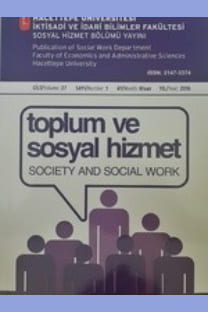ÇOCUKLARI ÇOCUK KORUMA SİSTEMİNE (ÇKS) GİREN AİLELERLE, BENZER SOSYAL ÇEVREDE YAŞAMALARINA KARŞIN ÇOCuKLARI İÇİN ÇKS’YE MÜRACAATÇI OLMAYAN AİLELERİN SOSYAL DESTEK AÇISINDAN KARŞILAŞTIRILMASI
Korunması gereken çocuklar, çocuk koruma sistemi, sosyal destek.
Compare the Families with Children who have Entered into the Child Welfare System with those Families who have not been Applied to the Child Protection System in Respect of Social Support
Child who need protect, child protection system, social support.,
___
- Aral, N. (1997). Fiziksel istismar ve çocuk. Anka¬ra: Tekışık Web Ofset Tesisleri.
- Ashman, K. K. ve Hull, G. H (1999). Understan- ding generalist practice. Chicago: Nelson Hall Publisher.
- Barker, R. L. (2003). The social work dictionary. Silver Spring, Md: NASW Press.
- Bertero, C. M. (2000). Types and sources of soci¬al support for people afficted with cancer. Nursing and Health Sciences, Vol: 2, 93-101.
- Cankurtaran Öntaş, Ö. (1999). Sosyal hizmet mesleğinde sosyal destek kavramı. Yaşam boyu sosyal hizmet: Prof. Dr. Sema KUT’a Armağan kitabı içinde ss: 146-151. Ankara: Hacettepe Üni¬versitesi, Sosyal Hizmetler Yüksekokulu.
- Caplan, G. ve Killika, M. (1974). Support systems and mutualhelp. New York.
- Duyan, V. (2003). Aileye yönelik planlı müdahale sürecinin aşamaları. Toplum ve Sosyal Hizmet. Ankara: H.Ü. SHY Yayını, Volume 14(1): 41-61. Eker, D. ve Arkar, H. (1995). Çok boyutlu algıla¬nan sosyal destek ölçeğinin faktör yapısı, geçerlik ve güvenirliği. Türk Psikoloji Dergisi.101(34): 45.
- Fraser, M. W. ve Jenson J. M. (Edit.). (2006). Soci¬al policy for children and families: A risk and resi- lienceperspective. Sage Publications, California. Holland, S. (2004). Child and family assesstment in social workpractice. Sage Publicatons.
- Işıkhan, V. (2007). Kanser ve sosyal destek. Top¬lum ve Sosyal Hizmet. Cilt 18, 1, ss. 15-29.
- Karataş, K. (2001). Toplumsal değişme ve aile. Toplum ve Sosyal Hizmet. Cilt: 12, Sayı: 2: 87-96. Massie, M. J. ve diğerleri. (1998). Psychitaric complications in cancer patients. Oxford textbo- ok of palliative medicine (Edited by Derek Doy- le, Geoffrey W. C. Hanks, Neil MacDonald), Se- cond Edition, Oxford Medical Publications, Ox- ford University Pres, 685-698.
- SHÇEK Genel Müdürlüğü, web sitesi.
- Tuna, P. (1993). Kanserli hastaların benlik saygısı üzerine bir araştırma. (Yayınlanmamış yüksek li¬sans tezi), Ankara, H. Ü. Sosyal Bilimler Enstitüsü. Uluğtekin, S. (2001). Yirminci yüzyılda Türkiye'nin çocukları: sorunlar ve beklentiler. Sosyal hizmet¬te yeni yaklaşımlar ve sorun alanları. Prof. Dr. Ni¬hal Turan’a armağan kitabı içinde, s. 7-19. Anka¬ra, H.Ü. SHYO Yayın. No:8.
- ISSN: 2147-3374
- Yayın Aralığı: Yılda 4 Sayı
- Başlangıç: 2000
- Yayıncı: Hacettepe Üniversitesi İktisadi ve İdari Bilimler Fakültesi
ÖZ-DENETİM ÖLÇEĞİ - ÖDÖ: GÜVENİRLİK VE GEÇERLİK ÇALIŞMASI
Veli DUYAN, Çiğdem GÜLDEN, Selahattin GELBAL
SOSYAL HİZMETTE KANITA DAYALI UY GULAMALAR: SOSYAL HİZMET EĞİTİMİ AÇISINDAN İRDELENMESİ
Yasemin ÖZKAN, Elif GÖKÇEARSLAN ÇİFCİ
YETİŞTİRME YURTLARINDA KALAN ÇOCUKLARIN KURULUŞA GELİŞ NEDENLERİNİN İNCELENMESİ
Nur Feyzal KESEN, Özlem KARAKUŞ, M. Engin DENİZ
ÇOCUK YUVALARI VE YETİŞTİRME YURTLARINDA ÇALIŞAN PERSONELİN EMPATİK EĞİLİM DÜZEYLERİNİN İNCELENMESİ
ANNE KARNINDAKİ BEBEK SAĞLIK DENETİM ODAĞI (AKBSDO) ÖLÇEĞİ: GÜVENİRLİK VE GEÇERLİK ÇALIŞMASI
Veli DUYAN, Sevgi ÖZCAN, Ayşegül CÖMERT OKUTUCU
ONKOLOJİ ÇALIŞANLARINDA DOLAYLI TRAVMATİZASYON ÜZERİNE BİR GÖZDEN GEÇİRME
Yaşlılarda Algılanan Sosyal Destek Üzerinde Etkili Olan Faktörlerin İncelenmesi
